This article first appeared in Forbes.
About halfway between the day you first heard about ChatGPT and the day you started wishing you never had, the news became all about a new era of thinking machines. Faster than you can say “Generative AI,” new models are moving into the spotlight, each claiming to be better than the last.
ChatGPT is drawing big names into the generative AI race.
ChatGPT, the groundbreaking chatbot developed by OpenAI, became the talk of the tech world almost overnight and is the most advanced chatbot to date. Predominantly a consumer-focused tool, it was designed to interact conversationally with a user, providing answers and responding to follow-up questions. Demonstrating the extraordinary ability of artificial intelligence to use machine learning to index retrievable content and mimic writing styles, ChatGPT can even adjust tone and voice when provided with direction.
OpenAI technology is also used to power Bing, Microsoft’s less popular search engine launched in 2009 that’s now making a phoenix-rising-from-the-ashes comeback. Claiming capabilities more powerful and accurate than ChatGPT, the company says they’ve applied the AI model to the Bing search ranking engine to increase the relevance of even basic search queries. While this might be true, I think they still have a long way to go. The technology has more than a few kinks—for one thing, it recently told one researcher it was in love with him.
And Microsoft is not alone in its conundrum of determining when these technologies might be ready for market. Despite having arguably the strongest alignment with AI-charged search capabilities, Google fast-tracked its own chatbot, Bard, in order to compete directly with ChatGPT. However, a factual error churned out during a marketing demo derailed its momentum and even caused the stock of its parent company, Alphabet, to drop 9% within a day. Regardless, it’s possible that Bard may ultimately gain an edge over ChatGPT given its access to a wealth of data when integrated into Google’s search engine.
As a specialist in the AI space, my company sees the rapid uptick in generative AI products as a positive. But the promise comes with peril. As of now, these technologies lack the hallmarks of fully enterprise-level solutions. As we observe a burgeoning new tech space, here are a few points to consider:
1. AI is a tool, not a threat, but we must assign it to the right tasks.
Consumer-level chatbot technology showcases what we in the AI space already know: that machine learning and intelligent technology can greatly enhance the human experience. One could argue that when AI takes on more repetitive, mundane business tasks—and does so with a near-zero error rate—people will be freed up to generate more creative contributions. In the HR arena, AI-driven tools can map the skill sets of entire organizations, revealing hidden talent and new opportunities that may have otherwise been missed.
2. Responsible AI means more than content filtering.
The companies producing these new publicly available chatbots talk about responsibility as the importance of mitigating harmful content. Microsoft, for example, says the new Bing implements safeguards to defend against issues such as misinformation and disinformation. But for an AI product to be truly responsible, the design itself must be responsible. We are seeing this in the HR tech world, as increasing regulations are being introduced to stave off unintended bias in hiring processes. Chatbots and similar technologies must include responsible AI components even before the first piece of content is generated.
3. Better is subjective.
In the scramble to eclipse ChatGPT’s entry into the market, its competitors were launched amid bold superlatives. Microsoft introduced Bing as the tool that would “reinvent search,” providing a faster and more powerful, accurate and capable option than ChatGPT. Meanwhile, Google Bard’s access to more recent data seemed beneficial in the race with ChatGPT, as the OpenAI chatbot model was initially restricted to data collected only through 2021.
When AI is tailored to enterprise-level functionality, however, what’s considered superior in one scenario may not translate to an advantage in another. Whereas industry-specific AI tools are designed to organize, analyze and structure data precisely enough to inform critical business decisions, vertical-specific leaders must build AI models that are based on industry know-how and language to perform specific tasks. Businesses utilizing such technologies also depend upon contractual assurances like Service Level Agreements (SLAs) to outline vendor expectations and set performance metrics, something open chatbots can’t provide.
Conclusion
No doubt the consumer-facing generative AI race is just beginning. Advances and missteps are an inevitable part of growth, but I look forward to seeing how it all plays out, with the hope that it helps people view AI anew, through the lens of curiosity and potential.



 Starting off the day, keynote speaker Commissioner Keith Sonderling of the EEOC shared insights on the expansion of Responsible AI governance across the U.S., emphasizing that current regulations put the onus on businesses using AI systems to ensure they generate fair end results–
Starting off the day, keynote speaker Commissioner Keith Sonderling of the EEOC shared insights on the expansion of Responsible AI governance across the U.S., emphasizing that current regulations put the onus on businesses using AI systems to ensure they generate fair end results– Talk of Responsible AI continued into the first panel
Talk of Responsible AI continued into the first panel  In conversation with retrain.ai’s Amy DeCicco, Dr. Anna Tavis of the Human Capital Management Department at New York University and Dr. Yustina Saleh from The Burning Glass Institute posed provocative questions, encouraging attendees to think about questions like whether empathy is truly a skill or a trait, or how HR leaders can tell from a skills profile whether or not a candidate will be able to do the job needed.
In conversation with retrain.ai’s Amy DeCicco, Dr. Anna Tavis of the Human Capital Management Department at New York University and Dr. Yustina Saleh from The Burning Glass Institute posed provocative questions, encouraging attendees to think about questions like whether empathy is truly a skill or a trait, or how HR leaders can tell from a skills profile whether or not a candidate will be able to do the job needed. With more enterprises talking about transforming to an SBO model, Dr. Sandra Loughlin of EPAM Systems shared lessons learned from her company’s transformation, while Heidi Ramirez-Perloff discussed The Estee Lauder Company’s exploration into SBO strategy. Urmi Majithia of Atlassian delved into executing technology to help overcome the challenges of becoming an SBO, and Ben Eubanks of Lighthouse Research &
With more enterprises talking about transforming to an SBO model, Dr. Sandra Loughlin of EPAM Systems shared lessons learned from her company’s transformation, while Heidi Ramirez-Perloff discussed The Estee Lauder Company’s exploration into SBO strategy. Urmi Majithia of Atlassian delved into executing technology to help overcome the challenges of becoming an SBO, and Ben Eubanks of Lighthouse Research &  Following the panel discussion, Dr. Loughlin sat down for a one-on-one with retrain.ai CEO Dr. Shay David to go more in depth into EPAM’s experience developing a thriving SBO strategy, sharing benefits, pitfalls and lessons learned along the way.
Following the panel discussion, Dr. Loughlin sat down for a one-on-one with retrain.ai CEO Dr. Shay David to go more in depth into EPAM’s experience developing a thriving SBO strategy, sharing benefits, pitfalls and lessons learned along the way. No discussion around Responsible HR would be complete without an exploration of the huge impact ChatGPT and other
No discussion around Responsible HR would be complete without an exploration of the huge impact ChatGPT and other 